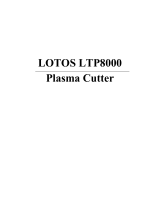
PROTECT YOURSELF AND OTHERS FROM POSSIBLE SERIOUS INJURY OR DEATH. KEEP CHILDREN
AWAY. PACEMAKER WEARERS SHOULD CONSULT WITH THEIR DOCTOR BEFORE OPERATING.
Read and understand the following safety highlights. For additional safety information it is strongly recommended that you
purchase a copy of “Safety in Welding & Cutting - ANSI Standard Z49.1” from the American Welding Society, P.O. Box
351040, Miami, Florida 33135 or CSA Standard W117.2.
BE SURE THAT ALL INSTALLATION, OPERATION, MAINTENANCE, AND REPAIR PROCEDURES ARE
PERFORMED ONLY BY QUALIFIED INDIVIDUALS.
CUTTING SPARKS can
cause fire or explosion.
4.a. Remove fire hazards from the plasma cut-
ting or gouging area. If this is not possible, cover
them to prevent the cutting or gouging sparks
from starting a fire. Remember that welding
sparks and hot materials from plasma cutting or gouging can
easily go through small cracks and openings to adjacent
areas. Avoid cutting or gouging near hydraulic lines. Have a
fire extinguisher readily available.
4.b. Where compressed gases are to be used at the job site, spe-
cial precautions should be used to prevent hazardous situa-
tions. Refer to “Safety in Welding and Cutting” (ANSI
Standard Z49.1) and the operating information for the equip-
ment being used.
ARC RAYS can burn.
2.a. Use safety glasses and a shield with the prop-
er filter and cover plates to protect your eyes from
sparks and the rays of the arc when performing or
observing plasma arc cutting or gouging.
Glasses,headshield and filter lens should conform
to ANSI Z87. I standards.
2.b. Use suitable clothing including gloves made from durable
flame-resistant material to protect your skin and that of your
helpers from the arc rays.
2.c. Protect other nearby personnel with suitable non-flammable
screening and/or warn them not to watch the arc nor expose
themselves to the arc rays or to hot spatter or metal.
ELECTRIC SHOCK can
kill.
1.a. The electrode and work (or ground) circuits
are electrically “hot” when the power source is on.
Do not touch these “hot” parts with your bare skin
or wet clothing. Wear dry, hole-free gloves to
insulate hands.
1.b. When the power source is operating voltages in excess of
250 volts are produced. This creates the potential for serious
electrical shock - potentially even fatal.
1.c. Insulate yourself from work and ground using dry insulation.
When cutting or gouging in damp locations, on metal frame-
work such as floors, gratings or scaffolds and when in posi-
tions such as sitting or lying, make certain the insulation is
large enough to cover your full area of physical contact with
work and ground.
1.d. Always be sure the work cable makes a good electrical con-
nection with the metal being cut or gouged. The connection
should be as close as possible to the area being cut or
gouged.
1.e. Ground the work or metal to be cut or gouged to a good elec-
trical (earth) ground.
1.f. Maintain the plasma torch, cable and work clamp in good,
safe operating condition. Replace damaged insulation.
1.g. Never dip the torch in water for cooling or plasma cut or
gouge in or under water.
1.h. When working above floor level, protect yourself from a fall
should you get a shock.
1.i. Operate the pilot arc with caution. The pilot arc is capable of
burning the operator, others or even piercing safety clothing.
1.j. Also see Items 4c and 6.
WARNING
PLASMA CUTTING or GOUGING can be hazardous.
FUMES AND GASES
can be dangerous.
3.a. Plasma cutting or gouging may produce
fumes and gases hazardous to health. Avoid
breathing these fumes and gases. When cutting
or gouging, keep your head out of the fumes. Use enough
ventilation and/or exhaust at the arc to keep fumes and
gases away from the breathing zone. When plasma cutting
or gouging on lead or cadmium plated steel and other
metals or coatings which produce highly toxic fumes,
keep exposure as low as possible and within applicable
OSHA PEL and ACGIH TLV limits using local exhaust or
mechanical ventilation. In confined spaces or in some
circumstances, outdoors, a respirator may be required.
Additional precautions are also required when welding
on galvanized steel.
3. b. The operation of plasma cutting or gouging fume control
equipment is affected by various factors including proper use
and positioning of the equipment, maintenance of the equip-
ment and the specific procedure and application involved.
Worker exposure level should be checked upon installation
and periodically thereafter to be certain it is within applicable
OSHA PEL and ACGIH TLV limits.
3.c. Do not use plasma cutting or gouging equipment in locations
near chlorinated hydrocarbon vapors coming from degreas-
ing, cleaning or spraying operations. The heat and rays of the
arc can react with solvent vapors to form phosgene, a highly
toxic gas, and other irritating products.
3.d. Gases used for plasma cutting and gouging can displace air
and cause injury or death. Always use enough ventilation,
especially in confined areas, to insure breathing air is safe.
3.e. Read and understand the manufacturerʼs instructions for this
equipment and follow your employerʼs safety practices.
i
SAFETY
i
























